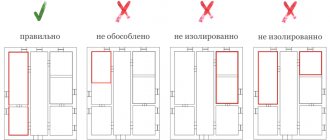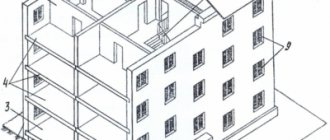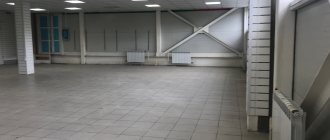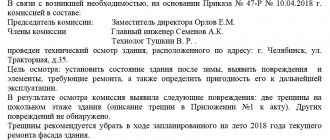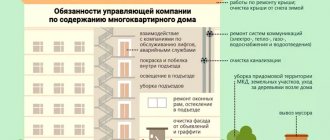15.11.2019
A huge number of different fire hazardous materials are stored or used in various factories and workshops. A potential explosion or fire in this case is a real threat. That is why it is very important to assess the degree of danger. Fire safety specialists categorize buildings and premises, which determines the operation of the facility.
What is a fire category?
It is quite difficult to classify production by explosion and fire hazard. In this question, 6 categories or classes can be distinguished, which are separated by Cyrillic letters from the letters A to E.
The fire category must be indicated at production sites. This factor determines the distance between areas, the number of evacuation exits and their size. This also affects the equipment that must be used to ensure fire safety at the facility.
Each object is supplemented with individual instructions that define the service requirements specific to this particular category.
Which premises require categorization?
Federal Law FZ-123 classifies communication facilities as production facilities, as well as everything related to engineering and transport infrastructure. According to modern regulations, category setting or categorization is required for all warehouse and production premises.
In addition, if we refer to paragraph 5.1.2 of the set of rules SP 4.13130.2009, it is necessary to determine the category for technical premises.
The list of premises requiring categorization includes:
- All kinds of storage;
- Any production and technical workshops;
- Workshops;
- Ventilation;
- Archives;
- Ironing and laundry;
- Boiler and compressor rooms;
- Server;
- Electrical switchboards;
- Garages;
- Premises with water metering units;
- ONE HUNDRED.
Why is this being done?
If you accurately determine and establish the category of the room, you can later present the appropriate requirements that determine the choice of fire protection systems. All these measures impact on ensuring maximum fire safety.
Thanks to the information function of determining the categories of premises, firefighters who arrive to extinguish a fire instantly get an overview of the threats and the scale of what awaits them behind the doors of a particular premises.
Who determines the category of explosion hazard and fire safety?
The answer to the question depends on the status of the building: is it still under construction or has already been commissioned.
If the facility is still under construction, then the fire hazard category will be determined by the company that prepared the project. This organization has a trained person on staff. If the facility is already in operation, then the categorization is carried out by an engineering service or a company providing fire safety measures.
Those premises and buildings that fall under categories B1-B4 and class P-IIa are objects whose category can be easily determined by a local engineer. For classification, it is necessary to study the building materials used for construction, the equipment stored indoors and the energy capabilities of the facility.
To determine the category of storage facilities with flammable materials, it is necessary to resort to more complex formulas.
Which rooms are fire hazardous by category?
According to the provisions of current regulations, the division of individual premises by fire hazard category is possible only upon completion of a whole range of measures to examine their current condition. They are carried out with the aim of taking the necessary preventive measures to ensure the protection of people, property and equipment from the destructive effects of fire.
When dividing premises into categories and classes, they are subject to special requirements requiring the fulfillment of certain conditions. In case of violation of these requirements, unpredictable consequences are possible, fraught not only with significant material losses, but also with a threat to human health.
Division into categories
In accordance with current construction standards, five categories of indoor spaces are distinguished according to their ability to effectively withstand fire and explosion hazards.
- The first of them is called category “A” and characterizes internal premises, which are usually classified as objects with increased fire activity. Dangerous mixtures, as well as highly flammable compounds with a flash point of no more than 28 degrees, can be stored or spilled in them. In addition, substances and materials that are highly explosive can be stored and used here.
- The second category of internal premises, designated “B” (simply fire and explosion hazardous objects), includes rooms in which it is allowed to store the same things with a fire temperature of more than 28 degrees.
- The third category of premises, divided into classes B1-B4, includes objects in which it is allowed to store and use flammable and slightly flammable liquid and solid substances that, under certain conditions, support free combustion.
- The fourth of the categorization positions under consideration includes premises with moderate danger, in which it is allowed to contain and use substances and mixtures that do not support combustion at all. In this case, the latter can be stored in a heated or molten state. During their processing, a significant amount of spark energy is released, provoking the appearance of dangerous fires.
- The fifth and final category (class) usually includes premises with a reduced fire hazard. Current regulations allow non-combustible materials to be stored in them in a non-heated state. The categories of buildings in terms of explosion and fire hazard are not much different from those already considered (relating only to premises).
Categories of premises according to explosion and fire hazard
| Room category | Characteristics of substances and materials located (circulating) in the premises |
| A – increased fire and explosion hazard | Combustible gases, flammable liquids with a flash point of not more than 28 °C in such quantities that they can form explosive vapor-gas mixtures, upon ignition of which a calculated excess explosion pressure in the room develops exceeding 5 kilopascals, and (or) substances and materials capable of exploding and burn when interacting with water, atmospheric oxygen or with each other, in such quantities that the calculated excess pressure of the explosion in the room exceeds 5 kPa. |
| B - explosion and fire hazard | Combustible dusts or fibers, flammable liquids with a flash point of more than 28 °C, flammable liquids in such quantities that they can form explosive dust-air or steam-air mixtures, the ignition of which develops a calculated excess explosion pressure in the room exceeding 5 kPa. |
| B1-B4 – fire hazard | Flammable and low-flammable liquids, solid flammable and low-flammable substances and materials (including dust and fibers), substances and materials that can only burn when interacting with water, air oxygen or with each other, provided that the rooms in which they are located (apply) do not belong to category A or B. |
| G – moderate fire hazard | Non-combustible substances and materials in a hot, incandescent or molten state, the processing of which is accompanied by the release of radiant heat, sparks and flames, and (or) flammable gases, liquids and solids that are burned or disposed of as fuel. |
| D – reduced fire hazard | Non-flammable substances and materials in a cold state. |
Definition of category B1-B4
| Room category | Specific fire load g, MJ/m2 | The specific fire load is defined as the ratio of the total fire load (the product of the quantity and the lower calorific value of the substance) to the area where it is located. If there are various flammable substances and materials in the room, the total fire load is determined as the sum of the products of the quantity and the lower calorific value of each type of substance.g = {Gi x Qi} / F, MJ/m2 |
| More than 2200 | ||
| 1401 – 2200 | ||
| 181 – 1400 | ||
| 1 — 180 |
Changing the functional purpose of non-residential premises: where to find order
Taking into account the uncertainty of the concept of the functional purpose of non-residential premises, we will consider 2 situations:
- It is required to convert non-residential premises into residential ones (or vice versa). The basic conditions of such a translation and the composition of the necessary documentation are regulated at the federal level (see Chapter 3 of the Housing Code of the Russian Federation).
- It is required to formalize a change in the type of production activity specified in the design documentation for non-residential premises. If such premises comply with sanitary, fire and other requirements (GOST, SP, i.e. sanitary rules) presented for premises in which the planned activity can be carried out (for example, for catering services, medical services, kindergartens, etc. ), then there is no need to obtain special permits specifically for conducting such activities in non-residential premises (we recommend reading our article on this topic: Obtaining a sanitary and epidemiological conclusion). In some cases, redevelopment may be required, which must be formalized in accordance with the law.
Important! Additional restrictions may be imposed on non-residential property owned by the state or municipality in a particular region.
Thus, the court recognized as an administrative offense the use of non-residential premises owned by the city of Moscow, not for the intended purpose specified in the lease agreement (see the decision of the Moscow Court of Justice dated May 16, 2016 in case No. A40-31532/2016-122- 268).
An interesting selection of judicial practice on the issue under consideration is offered by ConsultantPlus. If you do not yet have access to the ConsultantPlus system, obtain it for free.
Categories of buildings according to explosion and fire hazard
| Category | In the absence of automatic fire extinguishing | When protecting premises with automatic fire extinguishing systems |
| A | The area of category A premises exceeds 5% of the area of all premises or 200 m2 | The area of category A premises exceeds 25% of the area of all premises or more than 1000 m2 |
| B | The building does not belong to category A and the area of premises of categories A and B exceeds 5% of the area of all premises or 200 m2 | The area of premises of categories A and B exceeds 25% of the area of all premises or more than 1000 m2 |
| IN | The building does not belong to category A or B and the area of premises of categories A, B, B1, B2 and B3 exceeds 5% of all premises (10% in the absence of premises of categories A and B) | The total area of premises of categories A, B, B1, B2 and B3 in the building exceeds 25% of the area of all premises or more than 3500 m2 |
| G | The building does not belong to categories A, B, and C and the area of premises of categories A, B, B1, B2, B3 and D exceeds 5% of the area of all premises | The total area of premises of categories A, B, B1, B2, B3 and D in the building exceeds 25% of the area of all premises or more than 5000 m2 |
| D | If it does not belong to category A, B, C or D |
KVPO signs for buildings and premises
A public building must be equipped with a sign that eliminates errors in determining the fire hazard category. According to fire safety standards and regulations, owners and tenants must place signs with the hazard category on the doors of their buildings and premises. This sign must indicate the purpose of the room and two additional information:
- Risk of fire/explosion in the premises;
- Zone class according to PUE.
These signs allow working personnel, emergency services employees and everyone else to determine what exactly awaits them behind a given door. The photo shows various options for existing KVPO and ZON classes:
Occupational Safety and Health
The degree of safety of servicing electrical installations largely depends on the operating conditions and the nature of the environment of the premises in which the electrical equipment is installed.
Moisture, dust, caustic vapors, gases, high temperatures have a destructive effect on the insulation of electrical installations, thereby significantly)! deteriorate safety conditions.
In accordance with the rules for the construction of electrical installations, all rooms containing electrical installations are classified from the point of view of the danger of electric shock into the following three categories.
1. Premises without increased danger: dry, not hot, with a non-conductive floor, without conductive dust, as well as premises with a small number of metal objects, structures, machines, etc. or with an area fill factor k <; 0.2 (i.e., the ratio of the area occupied by metal objects to the area of the entire room).
2. Premises with increased danger: damp, in which, under normal conditions, the humidity can temporarily increase to saturation, as, for example, during sudden changes in temperature or when large amounts of steam are released; dry, unheated attics, unheated stairwells and heated rooms with short-term presence of moisture; rooms with conductive dust (coal mills, drawing shops and others like them); hot, i.e. rooms with temperatures above 30° C; rooms with conductive floors (earth, concrete, wood in a damp state).
3. Particularly dangerous premises: particularly damp premises; rooms with caustic vapors, gases and coolants that have a destructive effect on materials commonly used in electrical installations and reduce the resistance of the human body; rooms in which there are two or more danger signs (for example, a hot room and a conductive floor or a damp room with a fill factor of more than 0.2, etc.).
In order to avoid arbitrary interpretation of the definitions included in the classification of premises, according to the rules for the construction of electrical installations, premises with a relative humidity of not higher than 75% and a temperature of not lower than +5° C are considered dry, i.e. those in which the floor, walls and all items are normally in a dry state; Rooms with a relative humidity that constantly exceeds 75% or can temporarily rise to 100% are considered damp, since significant humidity can occur in these rooms when there is a sudden change in temperature or when a large amount of steam is released.
Particularly damp rooms are those in which the air is constantly saturated with water vapor, i.e. the relative humidity reaches 100% and as a result the floor, ceiling and all objects are constantly covered with moisture.
Rooms with conductive dust are those in which, due to the nature of production processes, electrically conductive dust (for example, coal, metal) can be released and collected in large quantities. This iin.ii, prevents the maintenance of proper insulation resistance of the electrical installation, and also reduces the resistance of the human body.
Rooms with caustic vapors or gases are those in which during the production process vapors or gases are released that have a destructive effect on insulating materials usually used in electrical installations. As a result, special measures must be taken to protect the insulation of electrical equipment. In addition to damaging the insulation of electrical equipment, these vapors and gases can also significantly reduce the resistance of the human body.
Hot rooms are characterized by high temperatures, causing drying and destruction of insulation, as well as excessive transpiration, increasing the risk of electric shock for persons in such rooms. A distinction is made between hot rooms - with temperatures above 30°C and especially hot rooms - with temperatures above 35°C.
Fire hazardous premises are those in which flammable objects are processed or stored or where production conditions may result in the formation of flammable gases, vapors, dust and fibers.
Explosive premises are those in which explosives are manufactured, processed or stored, or where explosive gases, vapors, or an explosive mixture with air can be formed.
The use of more advanced production technology, good ventilation and sealing makes it possible to significantly reduce the degree of danger in most industrial premises.
The conductivity of the floor is of particular importance for electrical safety. Dry end grain (without nails) or parquet floors have a fairly high resistance and are good at insulating a person from the ground. Conversely, brick, tile, concrete or earthen floors, whose resistance decreases sharply when wet, are poor insulators.
High-resistance floors can be a very effective protection measure. In shops with good end-grain, parquet or other high-resistance floors, single-phase contact may be less dangerous if the insulation is damaged.
As an analysis of electrical injuries shows, in enterprises with floors that have high electrical resistance, the possibility of electrical injuries during the operation of electrical equipment is significantly reduced.
However, when touching two phases at the same time, the insulating properties of the floor do not matter and electric shock is inevitable. {module 43}
Categories of outdoor installations according to explosion and fire hazards
| Outdoor category | Characteristics of substances and materials located (circulating) at the installation |
| AN - increased fire and explosion hazard | Combustible gases, flammable liquids with a flash point of no more than 28 °C, substances and materials capable of burning when interacting with water, atmospheric oxygen or with each other are stored, processed or transported (provided that the magnitude of the fire risk during the possible combustion of these substances with the formation pressure waves exceed one millionth per year at a distance of 30 meters from the outdoor installation) |
| BN - fire and explosion hazardous | Combustible dusts or fibers, flammable liquids with a flash point of more than 28 ° C, flammable liquids are stored, processed or transported (provided that the magnitude of the fire risk due to the possible combustion of dust and steam-air mixtures with the formation of pressure waves exceeds one millionth per year at a distance of 30 meters from outdoor installation) |
| VN - fire hazardous | Stored, processed or transported flammable and low-flammable liquids, solid flammable and low-flammable substances and materials (including dust and fibers), substances and materials that can burn when interacting with water, atmospheric oxygen or with each other, and if the installations are not classified as category AN or BN (provided that the fire risk from possible combustion of these substances and materials exceeds one millionth per year at a distance of 30 meters from the outdoor installation) |
| GN - moderate fire hazard | Non-flammable substances and materials are stored, processed, transported in a hot, incandescent or molten state, the processing of which is accompanied by the release of radiant heat, sparks and flames, as well as flammable gases, liquids and solids are burned or disposed of as fuel |
| DN - reduced fire hazard | Mainly non-flammable substances and materials are stored, processed, and transported in a cold state and if, according to the criteria listed above, it does not belong to the category AN, BN, VN or GN |
Fire hazardous objects: fire hazard categories, classification
Fire safety training
Fire hazardous objects: fire hazard categories, classification
Fire hazardous objects: what to classify as them
Fire safety briefing is carried out by the person responsible for fire safety, appointed by order (instruction) of the head of the organization with all employees of organizations with fire-hazardous production, regardless of qualifications, education, experience, nature of the work performed, at least once every six months. What is fire hazardous production?
Industrial production often uses substances that, under certain conditions, can lead to a fire or explosion. These substances include all kinds of flammable gases, flammable and flammable liquids, as well as some solids.
First of all, explosion- and fire-hazardous industries include continuous chemical production of various inorganic compounds, in particular, fertilizers, sulfuric and nitric acid, soda and the accompanying production of calcium chloride, a popular deicing agent.
There are industries whose technological cycle involves the presence of dusty combustible materials, the rapid ignition of which can also lead to an explosion.
Modern standards combine the concepts of fire and explosion hazard into a single whole - fire and explosion hazard. The use or storage in production of explosive and flammable substances under certain conditions determines their category in terms of explosion and fire hazard. There are five fire hazard categories in total, designated by letters of the Russian alphabet: A, B, C, D, D.
Fire hazard category A
In explosive factories of category A, flammable gases, as well as flammable liquids capable of forming fire-hazardous vapor-gas mixtures, are released as the cause of a possible explosion. The flash point of flammable mixtures for fire hazard category A, according to the accepted categorization, does not exceed 28°C, therefore, the operating mode of explosion and fire hazardous industries of category A requires special attention and the adoption of timely and regular measures to ensure fire safety.
Materials and substances whose ability to explode and burn when interacting with each other, with water, or with atmospheric oxygen are also the basis for assigning category A production in terms of explosion and fire hazard.
Fire hazard category B
Explosion and fire hazardous industries of category B are those in which flammable dusts or fibers, as well as flammable liquids, can cause a possible explosion and fire. The explosion and fire hazard factor in category B industries is the formation of explosive dust and steam-air mixtures with a flash point of more than 28°C.
Fire hazard category B
Actually, fire hazard categories (without the accompanying threat of explosion) include the following three: B, D and D. Category B is assigned to fire-hazardous industries, the technology of which involves the use of flammable and low-flammable substances and materials in liquid and solid states.
Substances and materials in industries that have fire hazard category B should not be explosive, but can only burn if they interact with water, atmospheric oxygen, or with each other.
When assigning fire hazard category B to production, it is important that the premises in which the relevant substances are present are not classified as category A or B.
Fire hazard category G
Fire hazard category G is assigned to industries whose technological cycle involves the processing of non-combustible substances and materials.
The fire hazard factor in category G production is due to the fact that, being in a hot, incandescent or molten state, non-flammable substances emit radiant heat, sparks or flames.
The use of fuel is another basis for assigning fire hazard category G to production. Category D for fire hazard occurs if flammable gases, liquids, and solids are burned or disposed of in production.
Fire hazard category D
Fire hazard category D is intended for industries that use non-combustible substances and materials in a cold state.
Classification of fire hazardous areas
The classification of fire hazardous areas is given in Article 18 of the Federal Law of July 22, 2008 N 123-FZ “Technical Regulations on Fire Safety Requirements”.
Fire hazardous areas are spaces indoors and outdoors, within which flammable (combustible) substances are constantly or periodically located and in which they can be present during normal technological processes or during its disruption.
The Rules for the Construction of Electrical Installations (PUE) divides fire hazardous areas into the following classes:
- Class P-I zones are zones located in rooms in which flammable liquids with a flash point above 61°C are handled.
- Class P-II zones are zones located in rooms in which flammable dusts or fibers with a lower flammable concentration limit of more than 65 g/m3 per volume of air are emitted.
- Class P-IIa zones are zones located in rooms in which solid flammable substances are handled.
- Class P-III zones are located outdoors, areas in which flammable liquids with a flash point above 61 ° C or solid flammable substances are handled.
Source: https://expert123.ru/pozharoopasnye-obekty-kategorii-pozharoopasnosti-klassifikatsiya/

